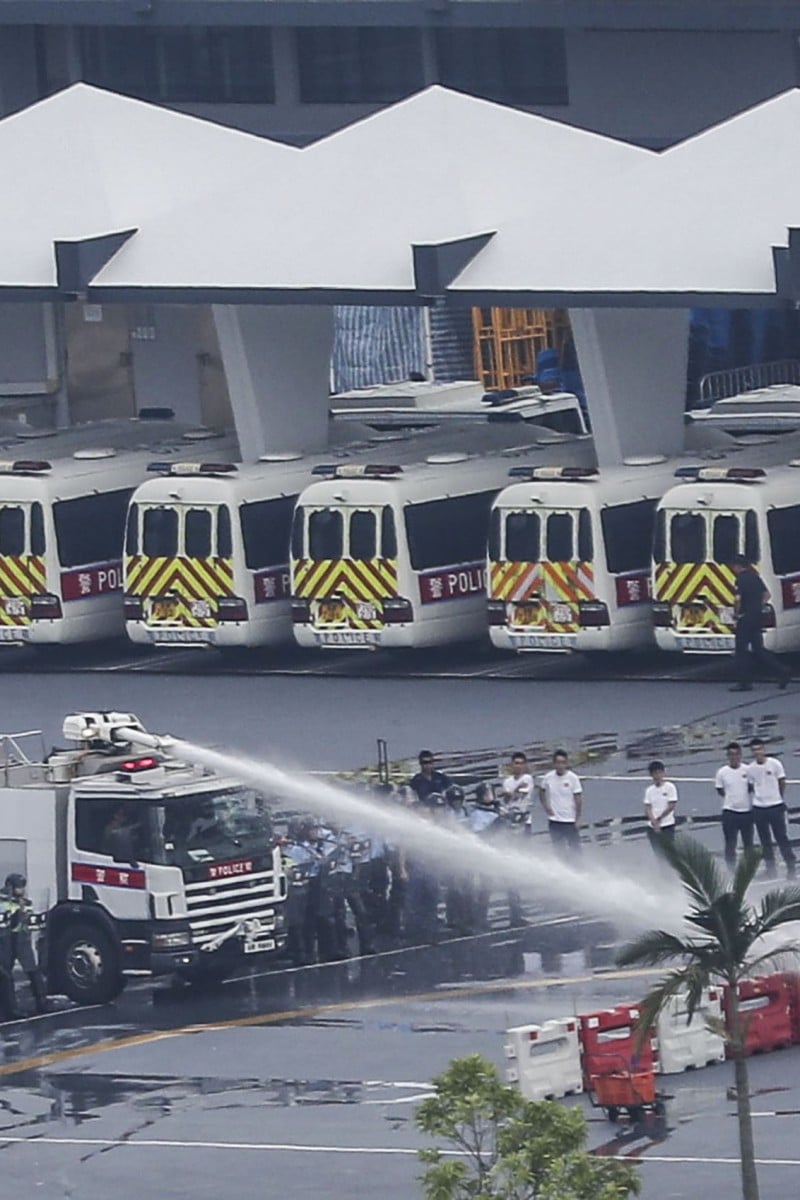 Police are weighing up whether to use the vehicles to spray liquid dye on radical protesters to make identifying suspects easier, according to a senior police insider. Photo: Edward Wong
Police are weighing up whether to use the vehicles to spray liquid dye on radical protesters to make identifying suspects easier, according to a senior police insider. Photo: Edward WongThree controversial anti-riot vehicles armed with water cannons will hit the streets of Hong Kong this week and be ready to handle unrest by mid-August if they pass road tests.
Operational guidelines had been finalised and the force was considering whether to use the vehicles to spray liquid dye on radical protesters to make identifying suspects easier, a senior police insider revealed.
Designed for crowd control and costing a total of HK$16.59 million (US$2.12 million), the Mercedes-Benz vehicles arrived in the city in May last year and have since been stationed at the Police Tactical Unit headquarters in Fanling for training.
Hong Kong protests: Marches to Causeway Bay and Sai Ying Pun are met with tear gas
While some top brass want to deploy the new alternative “as soon as possible” in light of escalating violence in recent protests, the armoured cars still need to pass road tests as requested, the insider said.
“The whole process and examination will take more than a week. If everything goes well, the specialised crowd-management vehicles can be deployed at large-scale assemblies from mid-August at the earliest.”
The insider added the vehicles would provide an alternative way of dispersing radical charging crowds, and create a safe distance between protesters and officers, minimising the possibility of physical confrontation and the risk of injury to those at the scene.
“Tear gas has not always dispersed crowds effectively at recent mass demonstrations. Protesters still attack us with bricks and metal rods. They even threw petrol bombs or our own tear gas canisters back at us over a very short distance,” the source said.
“If the situation and location allow, these vehicles are a better option to reclaim ground.”
According to operational guidelines, the use of the vehicles would only be considered if there was a serious injury, loss of life, widespread destruction of property or disruption of traffic by occupation of major thoroughfares resulting in significant consequences for public order or safety.
Human rights groups and some legislators have raised concerns over the potentially fatal water cannons. A South Korean farmer was seriously injured during a protest in 2015 when a police water cannon knocked him off his feet, causing him to smash his head on the road. He later died.
In a study by a local police monitoring group in 2015, Civil Rights Observer said jets of water could hit with 145kg of force from a distance of five metres and 127kg at 10 metres.
The assistant commissioner of police overseeing operations could authorise the vehicles’ deployment following a threat assessment.
The guidelines also stated any use should be in line with the Police General Order governing the use of force by officers.
The French custom-built vehicles each boast 15 high-pressure cannons. Tender documents show two cannons on the roof can fire more than 1,200 litres of water a minute over a distance of 50 metres.
The water can be mixed with tear gas or liquid dye that would allow police to identify the main protagonists after they are dispersed. The source said the colour spray was not a weapon but a tool to gather evidence.
Six cameras are installed on each vehicle.
“Those at the forefront charging at us could be sprayed with paint. The paint is hard to remove, so it is useful for us to identify who charged us,” he said. “But at this stage, we are still discussing whether it is an option.”
The force has repeatedly stressed over the past few weeks that officers were still being trained to use the vehicles, when asked whether water cannons would be deployed to handle mass extradition bill protests that have rocked Hong Kong since June 9.
Peaceful protests against the now-shelved bill, which would have allowed the transfer of fugitives to jurisdictions Hong Kong lacked an agreement with including mainland China, have often descended into violent clashes with police.
Officers have used tear gas, rubber bullets, beanbag rounds, sponge grenades and pepper spray to try and disperse radical protesters occupying roads overnight, with mixed results.
Police proposed buying the cannons in the government’s annual budget announced in February 2015, two months after the 79-day Occupy protests ended.
